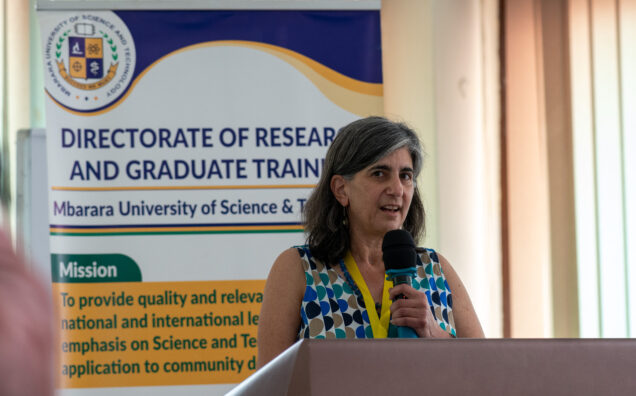Spotlight on… Judy Hahn

As told to URBAN ARCH Admin Core staff, November 2023
Tell us about your role in the International URBAN ARCH Center and in the recently funded BAHR study.
I helped launch the first URBAN ARCH Consortium back in 2011. We actually applied for a center grant first, but did not get funded. After that, we applied for a consortium. And so I was a big part of leading what we called the Uganda Cohort with Dr. Winnie Muyindike back in 2011. With Dr. Winnie and other excellent collaborators, I was able to co-lead lots of studies on alcohol and HIV issues of the day in Uganda. I am currently leading the TRAC study, which is a project within the International URBAN ARCH Center, and in that study we are looking at new TB that seems to occur frequently among people with HIV who consume alcohol.
Now I am also leading the BAHR study, which is an R01 study that leverages the really exciting fact that more and more investigators have been able to get blood spots and test for phosphatidylethanol (PEth) in order to obtain an objective measure of alcohol use. And the main goal of the BAHR study is to leverage all those data in bringing them together to do pooled and IPD meta-analyses to get the most out of those data. IPD meta-analyses are individual participant data meta-analyses, where you actually have the raw data to bring together rather than just pulling the summary statistics from the journal articles for meta-analyses. The BAHR study was funded about a year and a half ago. We’re in our second year out of three.
The first aim of the study is pulling data from several studies. We have six studies looking at the association between alcohol use and viral suppression and the VACS index, which is a marker for mortality risk. So in Aim 1 we’re investigating what happens when you use the biomarker to look at that association when combined with self-report, as opposed to self-report alone.
The second aim is gathering together all of the randomized control trials, which all had either a primary or secondary aim of reducing alcohol use among persons with HIV. I think there are about 15 trials we found that measured PEth, but very few of them had that as part of their primary endpoint. So we’re reanalyzing the data, bringing them together to see the effect of these interventions on a combined PEth plus self-report measure, so that we can really feel sure about the strength of these interventions. We’ll also look at the intervention’s efficacy and see whether this varies by intervention type, and whether the intervention further on also leads to viral suppression, since all of these studies were conducted among people with HIV. So that’s the second aim, which is very exciting.
And then the third aim is looking at PEth alternatives. Given the fact that PEth testing is expensive and not particularly accessible to low-resource settings and not very useful for everyday clinical care for that same reason, can we come up with an alternative to PEth? For this aim, we’re using a wealth of biological data from one of our collaborating studies, the Multicenter AIDS Cohort Study (MACS) / Women’s Interagency HIV Study (WIHS) Combined Cohort Study (MACS/WIHS-CSS). This study has thousands of participants and has been collecting PEth and all sorts of other measures. We’re using machine learning to see if maybe a combination of those other measures could be a reasonable approximation to PEth for studies or clinical care that can’t afford PEth, or maybe historic studies that just don’t have it but may have these other measures. So BAHR is really a study leveraging the data that have already been collected to find out a lot more about alcohol use and how alcohol use affects HIV and how we can mitigate its harm.

When we first interviewed you about your work back in 2015, you mentioned that you thought future lines of research in Uganda would include more biological questions. Now you are looking at biomarkers for HIV and alcohol use in the BAHR study. Why are you interested in studying biomarkers specifically? What is their importance in this field of research?
I love biomarkers! I think alcohol is a pretty tough problem, and it’s hard to measure it. It’s actually been quite exciting to use the biomarkers, and certainly they’re an incredibly useful research tool. My research over at least the first 10 years of using the biomarkers was just in terms of measuring alcohol in observational studies, especially among people with HIV. We then started using them to measure how well we’re doing with interventions, which seemed like it was the next phase. We really want to help people with alcohol use, but if we don’t know if they really are changing their alcohol use, that’s problematic. I think the next phase is figuring out whether we can actually use the biomarkers with participants. Are they useful? Is it useful to get your biomarker results? Is it going to be motivating? Can it actually be part of interventions to help people reduce their alcohol use? Or maybe even just as a part of routine care where you have a checklist of things that get tested. Your provider could look at that and say “By the way, this biomarker looks high, and maybe we should talk about how that’s affecting your health and see if there are ways to reduce that.” To me, that’s the next frontier. There are issues with it, of course, because I think people are pretty sensitive about getting these kind of results, especially if they haven’t been honest about their alcohol use, and we don’t want it to be confrontational. But I think, just like measuring your blood pressure or getting your hemoglobin A1C, biomarkers can be an incredibly important tool in clinical care and in substance use treatment. But figuring out how best to do that and how to get the biomarkers to these types of settings is a whole other issue. And we know that people with HIV are greatly impacted by alcohol use. That’s why biomarkers are important in this field. And, to the credit of NIAAA, I think that the field of alcohol/HIV research has been leading the way with alcohol biomarkers, which is something to be excited about and something that I hope we can keep doing.
Can you tell us about the current status of the BAHR study?
We submitted a CROI abstract for Aim 1; it got accepted for an oral presentation, which is very exciting. That abstract is looking at biomarkers and viral suppression. We also have a methods manuscript for Aim 2, which is being led by Jeremy Kane. We had to work on getting access to all of the data first, which takes some significant work in terms of putting together the data use agreements (DUAs) and cleaning the data. Now we have all of the final DUAs and we’ve received most of the data, and we have our protocols ready for analysis, so once we receive all the data we’ll begin analyzing them, probably in the next few months. For Aim 3, we are working on the machine learning methods. We actually didn’t have all the data that we wanted for that immediately, so we are waiting on that a little bit. But in the meantime, Cristina Espinosa da Silva, who is leading that aim, has been doing some machine learning work on some of our other data. So there should be some results coming soon that we’ll be excited to share.

What are some challenges you’ve faced so far with this study? Any lessons learned?
The biggest lesson learned, a happy one, is how wonderfully collaborative everyone is. It’s really great, and it’s such exciting work, and I was thrilled that everyone who had relevant data was willing to share their data. I’m also trying to use the BAHR study as a launching point for a biomarker and biospecimen data repository, so that other people can do similar things. I think there are more questions out there than the ones we asked in BAHR. And I think there are some really great opportunities for people who want to dig into data, but a related lesson is that data use agreements take some effort, and they are really necessary these days. I remember doing an IPD meta-analysis where I just asked people for data and they gave it to me! But this is a new world and now every single collaborator sending data has a data use agreement for the study. So that takes effort, but it’s a good thing I think. Other than that, it’s been very smooth. There’s great people working on the team – working with MAC/WIHS is a really nice thing, and working with other collaborators at UCSF has been great too. Working with Jeremy Kane, who’s leading Aim 2, and Cristina leading Aim 3 has been wonderful.
What are you most excited for looking ahead to the future of the BAHR study?
To find out the results- I’ve been thinking about some of these hypotheses for many years, so I’m very curious to see what we find out. I’m also excited to see how we can leverage the results and think about the next steps of how we can move this kind of measurement into something actionable, something that can be used by patients and clinicians.
In your previous interview, you told us you like to play tennis and snowboard. Any new hobbies to report since then?
You know, two years ago I broke my shoulder bicycling, so that kind of put a damper on my tennis playing. I do love playing tennis though! I also quilt and I sew, although not as much as I’d like to. A crazy hobby I’ve taken on is fixing up old sewing machines. My oldest one is from 1889. I have them all the way up through about 1950 or 60.
Any other comments?
It’s been exciting to see what we’ve accomplished together as a group. Being a part of the URBAN ARCH Consortium and now the International URBAN ARCH Center is really great – sometimes we’re working on similar things, sometimes there are divergent things but we’re able to bounce ideas off of each other. The Annual Meetings always feed that excitement and going to those has always been a positive experience. And my sister always likes when I come to Boston!
